We may earn money or products from the companies mentioned in this post.
Set on Croatia’s gorgeous Dalmatian coastline, overlooking the crystalline waters of the Adriatic Coast, the city of Split has really soared in popularity in recent years. If you decide to visit, you will find that there is no shortage of interesting things to see and do here. But maybe you’ve got time and wonder about day trips from Split, Croatia.
From the Diocletian’s Palace, lively Marmont Street, and Bačvice Beach to the Cathedral of St. Duje, there is something for everyone in Split. However, you certainly shouldn’t just limit yourself to exploring things within the confines of the city either.
If you are interested in a change of pace, you will be delighted to hear that there are also tons of gorgeous day trips from Split that you can take, to beautiful destinations situated just a couple of hours away.
11 Best Day Trips From Split, Croatia
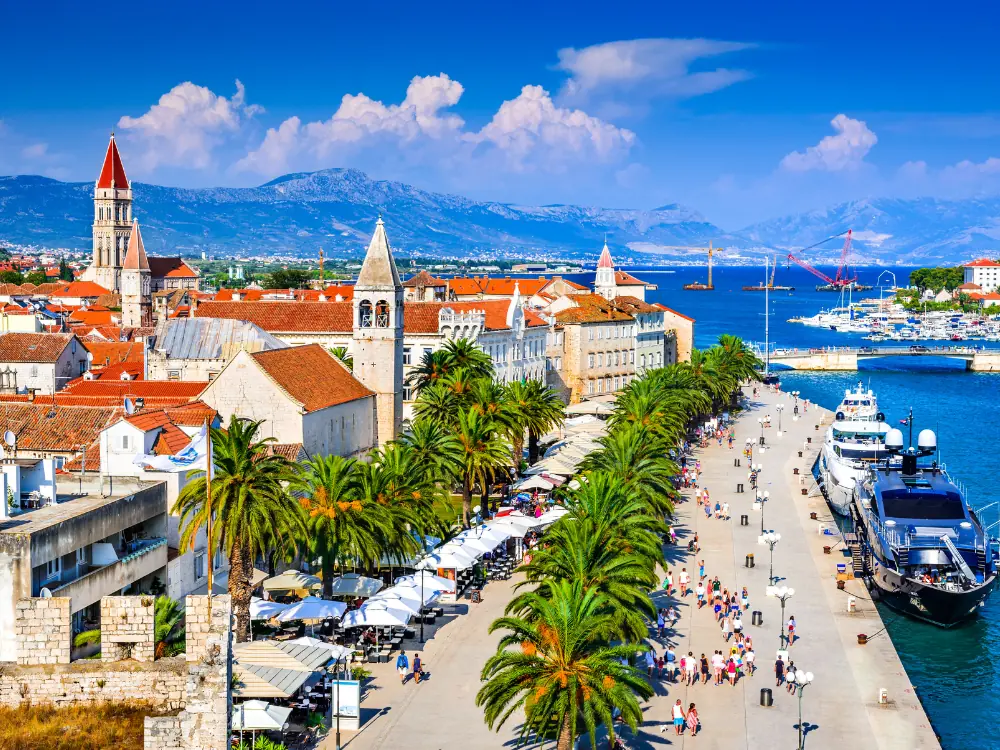
Trogir
This magnificent town, which is a perfect mix of Renaissance, Baroque, and Romanesque architecture, is located only 27 km and 40 minutes drive from Split, but you can also choose to travel by ferry, privately owned by Bura Lines.
Trogir, whose city center is located on a small island between the mainland and Čiovo Island, is connected to the rest of the coast by two bridges, the old Čiovo Bridge and the Croatian Veterans Bridge.
This small town was included in UNESCO’s list of world cultural heritage sites in 1997 thanks to its cathedral, numerous churches, the Prince’s Palace, the palace of the Ćipiko family, and the Renaissance southern city gate or porta civitatis built in 1953. But of all of the beautiful sights here, one that really stands out to tourists is the Kamerlengo castle, the most famous symbol of Trogir.
The castle was built in the 15th century when Dalmatia was ruled by Venice, with the purpose of defending the city against the Ottoman Empire. At certain points in history, it was used as a strategic base and home for the Venetian army.
If you decide to visit the castle (and you should!), admission includes entrance to the oldest part of the castle, its 14th-century tower, and the chapel of St. Mark.
You can easily spend an entire day in Trogir, exploring the city on foot and getting lost in its various streets and passageways. After all that walking, don’t forget to visit the Trogir waterfront which is home to countless restaurants and cafes.
The food is exquisite, despite being a “touristy” area. (Be sure to try the truffle pasta!) Not only is the atmosphere here great, you also have an unparalleled view of the harbor and the numerous luxury yachts from all over the world that drop their anchors here each day.
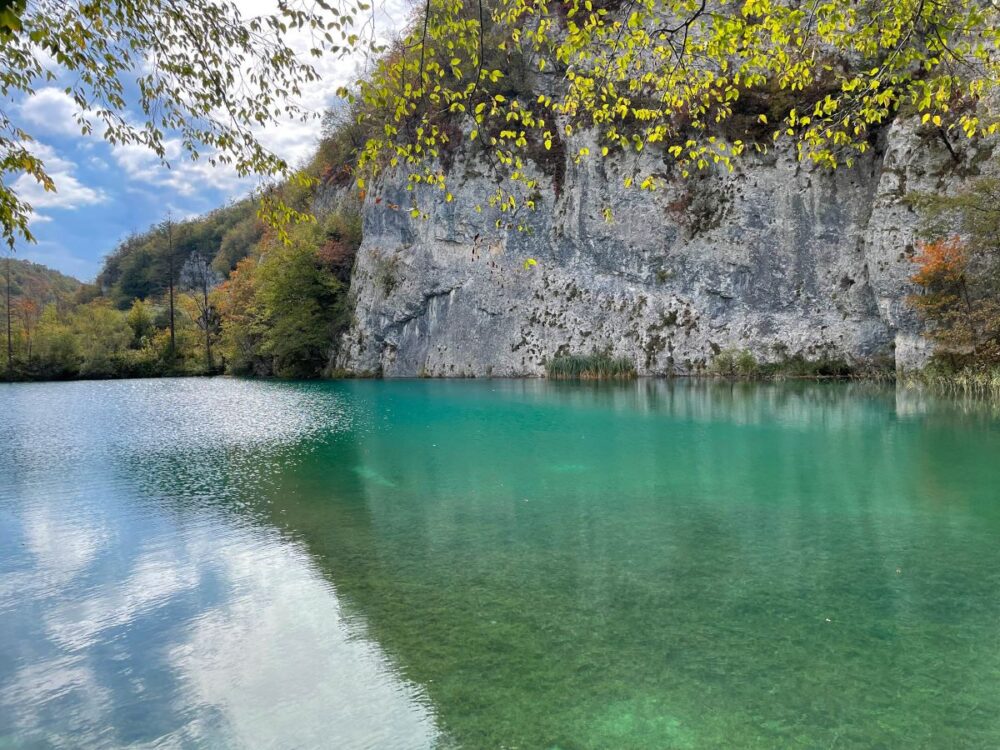
Plitvice National Park
Plitvice Lakes National Park awaits just 250 kilometers or a 3-hour drive from the city of Split. It is considered by many to be the most beautiful national park in Croatia, with many locals going so far as to say that you haven’t really seen Croatia if you haven’t visited the park.
The park was inaugurated as a National Park way back in 1949, making it the largest and oldest national park in Croatia. It consists of 16 natural lakes connected by endless rivers and streams, and the Plitvice Lakes are a shining example of beautiful travertine barriers created by the deposition of calcite over tens of thousands of years.
The park is also home to the famous Korana Spring, and two more artificial lakes were built over time. Each of the natural lakes here is more beautiful than the last.
Be sure to add Prošćansko jezero, Ciginovac, Okrugljak, Batinovac, Veliko jezero, Malo jezero, Vir, Galovac, and Milino jezero lakes to your radar. (Ok it’s a lot and the names are kind of confusing! To be honest, you cannot go wrong with )
There are also many caves and pits available to visitors in the park, and, fascinatingly, the remains of the bones of a cave bear, a species that became extinct 24,000 years ago, were also found in Mračna and Rodića caves.
To refresh yourself after a long walk and exploring the magnificent Plitvice Lakes, treat yourself to a meal at one of the most famous regional Lika restaurants, the Lika House. This rustic restaurant offers authentic Lika dishes (like smoked Lika prosciutto, mutton, boar, and paprika sausages) with an open fireplace prepared by some of the best chefs in all of Croatia.
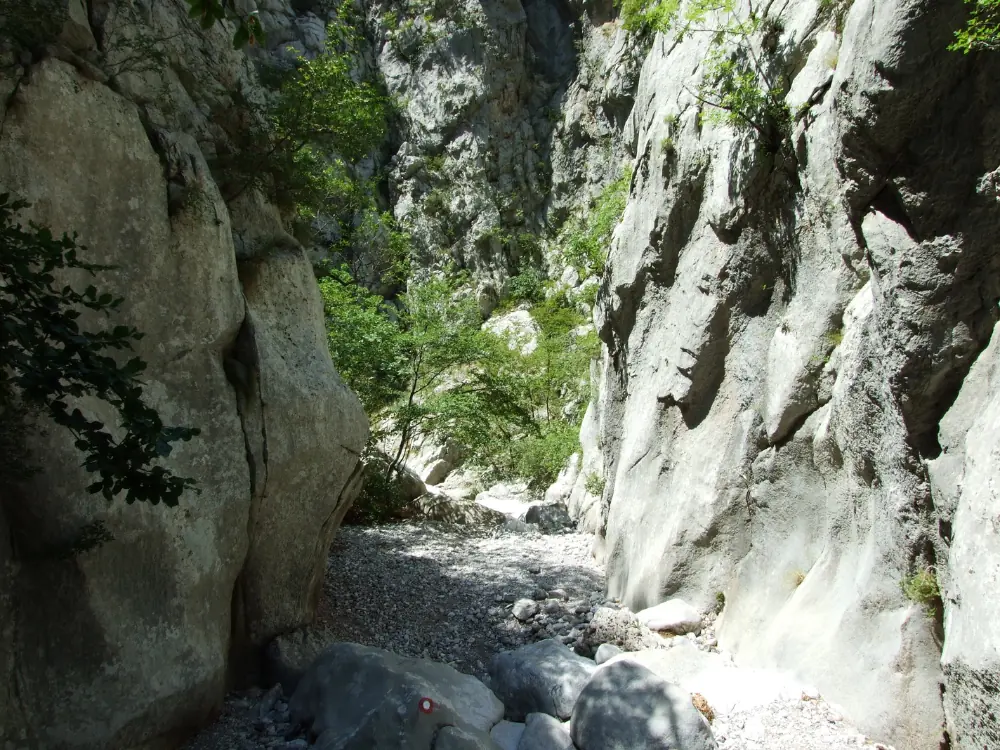
Paklenica National Park
Paklenica National Park, located 170 km and a 3 hours drive from Split is the second oldest national park in Croatia and it stretches along the slopes of South Velebit.
It is massively overlooked in favor of Plitvice Lakes so if you are traveling to Croatia during the high season and searching for somewhere that offers all the nature and beauty of Plitvice without the crowds, you will love this spot.
There are two impressive natural canyons which you can explore and hike down in Paklenica. Namely, they are the Velika Paklenica which is 14 km long and up to 800 m wide, and Mala Paklenica which is 12 km long and up to 500 m wide.
There are some fantastic hiking trails in the region that lead you through the canyons, the Manita Peć cave and extend over 200km in length, crossing the entire region of Velebit.
If you prefer slightly more adrenaline-focused activities, you will no doubt also love the various rock climbing areas that can be found around the park – the most famous of which is no doubt Anića kuk, which offers 350 m of climbing sections.
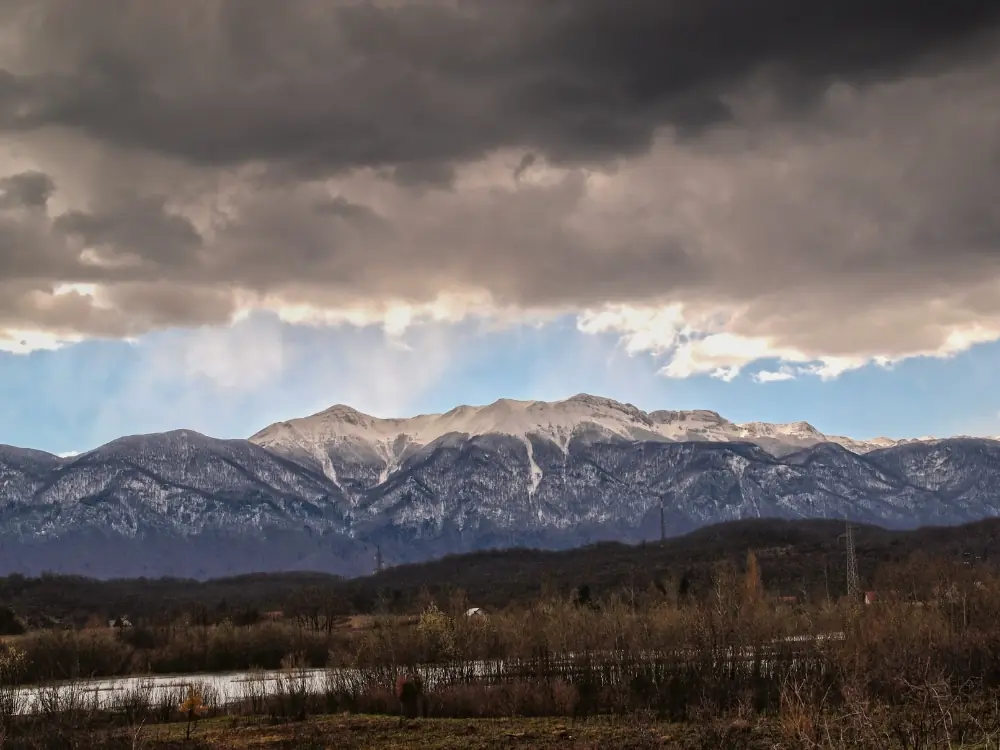
Velebit Nature Park
If you head out to the natural parks of Lika, such as Paklenica or Plitvice Lakes, you should also stop by the off-the-beaten-path Velebit nature park, if your itinerary allows.
This is the largest protected area in Croatia and the nature reserves Hajdučki and Rožanski kukovi found within it are a paradise for mountaineers, alpinists, and speleologists. You should also take some time to visit Kuterevo.
The Kuterevo Bear Sanctuary has existed since 2002 and was started by the Kuterevo Velebit Association. It provides refuge for young bears that were left without their mothers due to poaching or accidents.
(A lot of people are not aware that bears can be found in mountainous areas of Croatia, Greece, and other areas of the Balkans!) This reserve is a wonderful initiative for helping the animals and if you stop by, you can learn more about bears and their habitats.
If you are hanging out in Croatia a little longer and may be traveling in the country for several weeks/months, you can also volunteer and help with the bears. Kuterevo welcomes volunteers from all over the world!
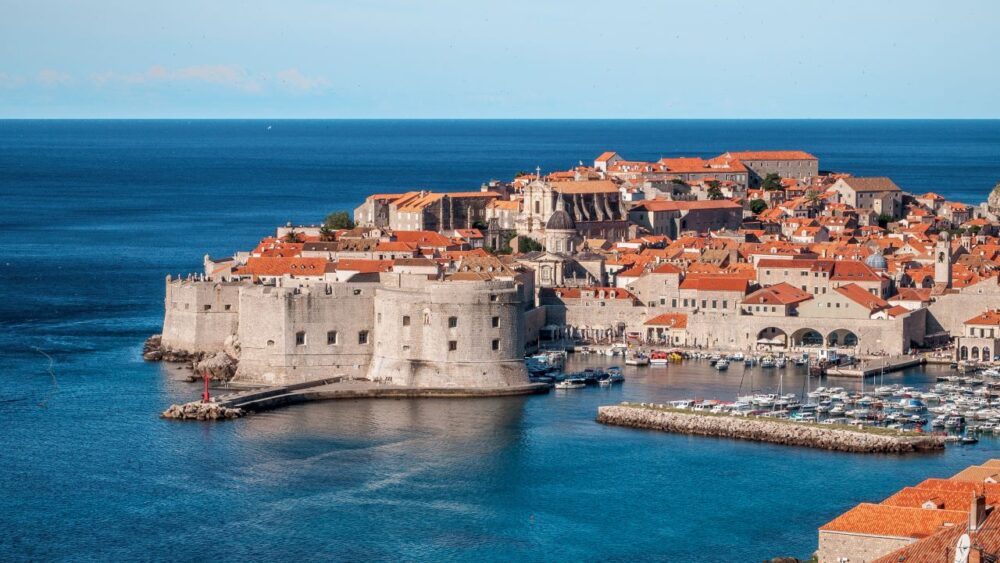
Dubrovnik
Dubrovnik, also known as the “Pearl of the Adriatic” is a city located on the coast of southern Croatia. It arguably needs no introduction since it has rapidly become one of the most popular travel destinations in Europe, particularly since the release of the Game of Thrones series and all the hype around it.
Dubrovnik sits 220km and is a 3-hour drive east of Split. Itis known for its stunning architecture, rich history, and beautiful vistas.
Visit the Old Town of Dubrovnik and the city walls, part of the UNESCO World Heritage Site, which dates back to the 7th century. The city walls that surround Dubrovnik offer a wonderful view of the city itself and the Adriatic Sea.
The main street in the city is known as “Stradun” and it is lined with dozens of excellent restaurants, cafes, and shops. The old town is home to many museums, including the Maritime Museum, which showcases Dubrovnik’s rich maritime history.
For fans of the television show Game of Thrones, visit the island of Lokrum, one of the locations where the scenes from Quarth were filmed, and the Lovrijenac fortress, also known as the “Gibraltar of Dubrovnik” and a symbol of resistance to the Venetian Republic.
The fortress is located right next to the walls of the Old Town at 37 meters above sea level and was built in the 11th century. Lovrijenac offers a wonderful view of the city and the sea and can be reached by a forested path across the seashore in Piles.
For a more relaxing experience by the coast, be sure to go for a dip at Copacabana, one of the largest beaches in Dubrovnik. This is the perfect beach for fun-seeking visitors too – you can play volleyball, rent a kayak, enjoy parasailing, and enjoy artistic sculptures and installations.
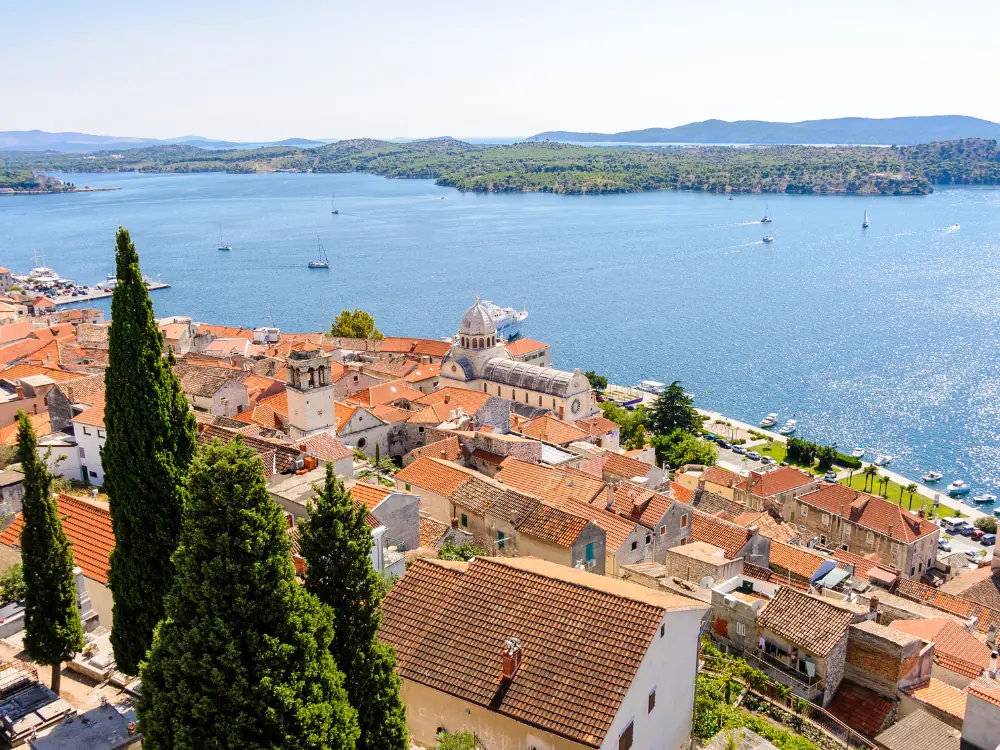
Šibenik
Šibenik is located 70 kilometers from Split at the mouth of the Krka River. This small town is the only town on the Croatian coast that was not built on the foundations of old Illyrian settlements, which makes it the oldest indigenous town on the Adriatic.
In addition to being the cultural and economic centre of Šibenik-Knin County, this city is also special in that it is one of only a few cities in the world that has two cultural assets on the UNESCO World Cultural Heritage List.
The first is the Cathedral of St. James from the 14th century, with the construction lasting more than a hundred years, which is why Gothic and Renaissance are interwoven through its walls and decorations.
The second is the fortress of Saint Nicholas, an imposing fortification located at the entrance to the Saint Anthony channel. This fortress is part of the Venetian defense line, which consists of 6 fortresses, which stretch over 1000 kilometers of the Adriatic coast.
Šibenik is also on the list of locations where the television series Game of Thrones was filmed. In the series, Šibenik was the city of “Bravos” and the Cathedral of St James was actually the “Iron Bank”.
A little further out of the city center, be sure to explore the fortresses of St. Mihovil and the fortress of Barone.
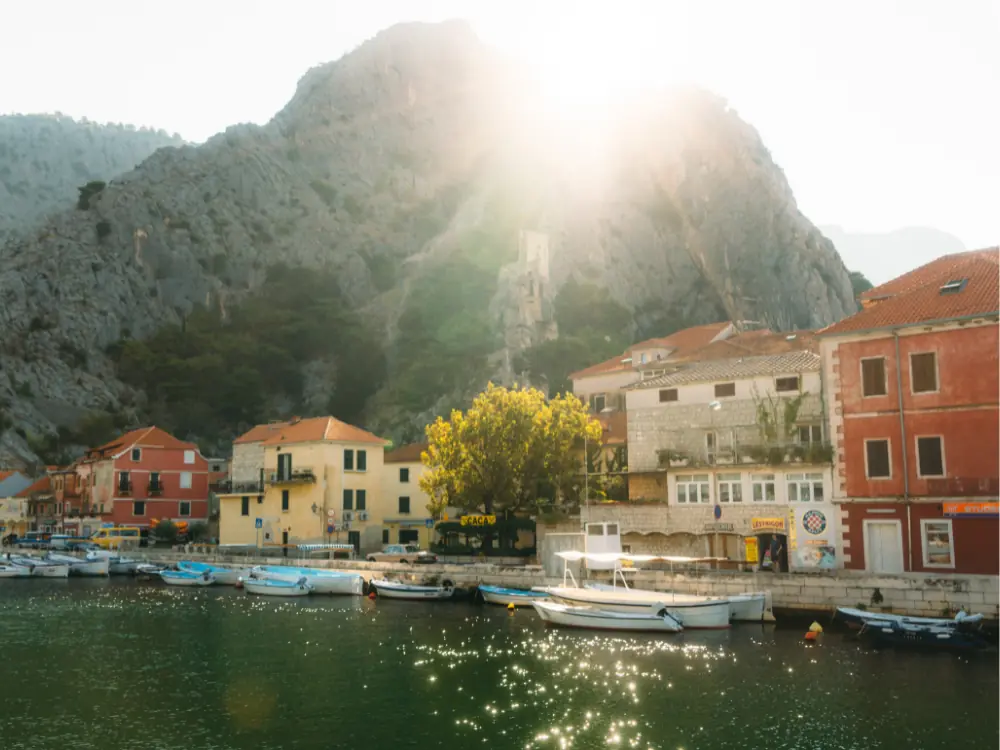
Omiš
In the immediate vicinity of Split, only 25 kilometres away, you will find the seldom-visited town of Omiš. This scenic locale is located at the mouth of the crystal-clear Cetina River, with the Dina on one side and the sea on the other.
It is affectionately nicknamed the “city of pirates” by Croatians because many of its inhabitants engaged worked in this illegal trade during the 12th and 13th centuries. They considered themselves “rulers of the sea” and kept their boats, known as the Omiš arrows in the Cetina River canyon, always alert and ready to defend the city.
Every twist and turn in Omiš greets you with a breathtaking view that looks like something from a postcard. From the town center, you have a unique view of the surrounding mountains in the distance, while along the coast, you can enjoy over 5km of magical sandy beaches and a fantastic selection of restaurants serving local and international fare.
Sandy beaches are not very common in Croatia (most of them are stone/pebble beaches) so encountering the soft, powdery golden sand in Omiš is really something special.
While you are in town, you must visit Fortica or Starigrad, a pirate’s fortress on top of the Omiš Dinara, from which you can enjoy a view of Cetina, the entire Brač channel, and the islands of Brač, Hvar, and Šolta.
Take a look at the four-story Mirabela fortress, which once served as an observation post for the defense of the city. Spend some time wandering through the beautiful medieval center, stopping for a coffee or an Aperol spritz here and there as you go.
If you want adventure, you can also head to the Cetina Canyon and try your hand at white water rafting and then stop by Radmanovo Mlinice and eat the best soparnik in Croatia. This is a dish made from dough, Swiss chard, garlic, and olive oil.
Above Omiš and the Cetina canyon, visit the monument to Mila Gojsalić, the work of Ivan Meštrović. This famous heroine sacrificed her life in 1530 in the defence of Poljica against the Turks.
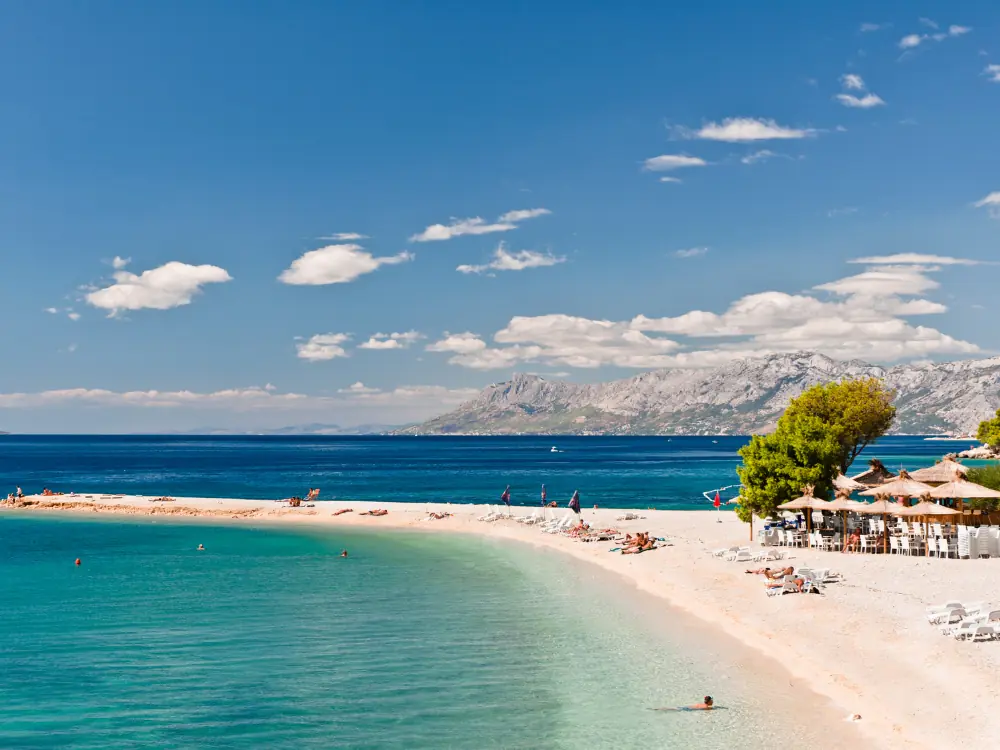
Makarska and Biokovo
Only an hour from Split is Makarska, a tourist pearl at the foot of Biokovo. This beautiful city is known for its Riviera, but above all, the most famous symbol of the city is Biokovo.
This second-highest mountain in Croatia, located between Cetina and Neretva, is home to a beautiful nature park. From the highest peak of Biokovo, St. George at 1762 m above sea level, you can see the Adriatic and Italy on one side, and Herzegovina and neighboring Bosnia on the other.
The surface of the park covers almost 200 km2, and within its grasp, it is home to more than 400 caves and pits. Biokovo is also home to many endemic species and about 300 species of wild plants.
There are geomorphological reserves and special forest vegetation reserves in the nature park, and the area is a frequent choice for walkers and mountaineers due to its large number of hiking trails.
Of all the stunning trails and sights available, one of the most interesting stopping points for tourists is no doubt the Nebeska šetnica – Biokovo Skywalk.
This is a glass platform in the shape of a horseshoe which is located on the slopes of Biokovo above Makarska at 1228 meters above sea level. It rises 11 meters from the edge of the cliff and is the first skywalk to have ever been built in Croatia. (You might recognize it from your Instagram feeds during the summer!)
Biokovo Nature Park is visited annually by more than 50,000 tourists. If you decide to discover this natural beauty yourself, be sure to make an appointment online due to the limited number of vehicles that are allowed to pass through Biokovo every hour.
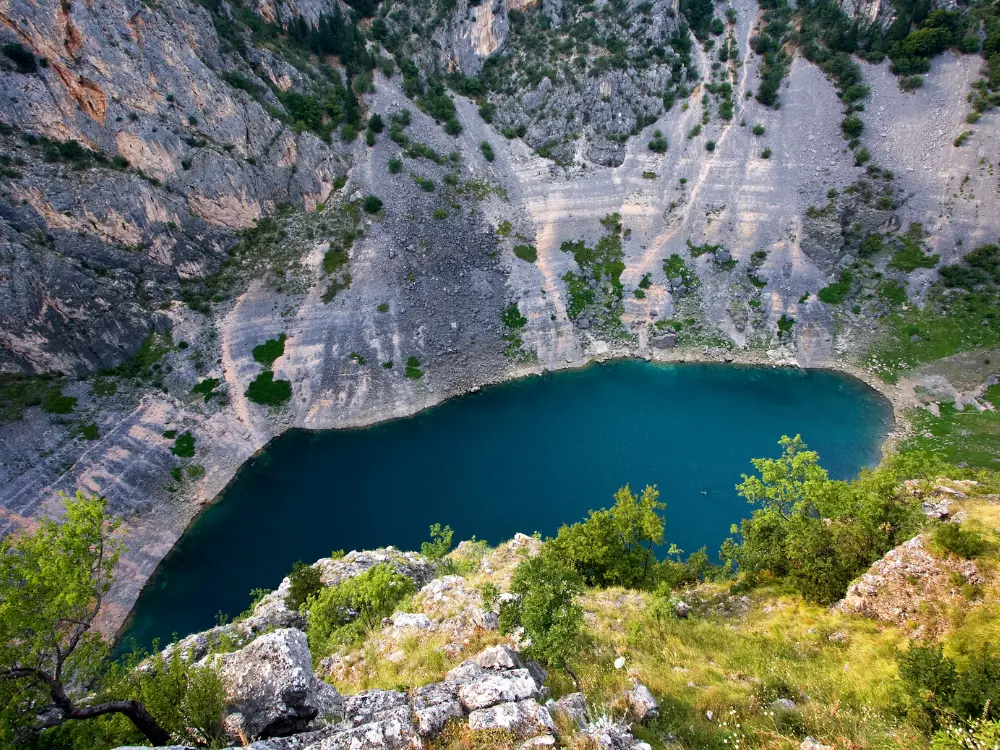
Imotski
Imotski is a hidden treasure of the Imotska Krajina, located just 87km away from Split. This beautiful town is connected to the Makarska Tunnel Sveti Jure, a 4248 m long tunnel that passes through the very heart of Biokovo.
This small town is known for its residents’ obscure love for all things related to the Mercedes Benz brand. (It is the town with the highest number of Mercedes Benz owners in the world, and there is even a Mercedes monument here!)
But more interestingly for tourists, Imotski is home to the Topana fortress and the Blue and Red Lakes.
The Blue Lake is one of the most beautiful lakes in Croatia. During the spring and autumn months, it is a popular place for locals to go swimming with their family and friends, while during the hot summer months, it occasionally dries up completely. When it is dry, the bottom of the lake becomes the site of football matches between the local teams, the Werewolves and the Elves.
A walking path called the educational ecological path of Imotski leads from the Topana fortress to the lake and makes a wonderful place to go for a walk or a picnic.
Meanwhile, the Red Lake got its name thanks to the reflection of the surrounding red rocks that give the lake a reddish color when they bounce off the water. There is only a distance of 2km between the 2 lakes.
The Topana fortress, located on the cliffs above the Blue Lake is also well worth a visit. It is 40 meters long, and the lake runs around two sides of it, almost like the moat of a castle.
The fortress dates to the 14 century with even older earlier layers also archaeologically preserved.

Krka National Park
Krka National Park is located 90km from Split. It stretches along the Krka River and offers plenty of attractions for visitors.
It is famous for its 7 travertine waterfalls – Bilušića buk, Brljan Waterfall, Manojlovački Waterfalls, Rošnjak Waterfall, Miljacka Waterfall, Roški Waterfall and the most famous to tourists, Skradinski Buk.
With circular cycling routes, 22 hiking routes, and 5 magnificent viewpoints, Krka National Park is a nature lover’s dream come true. If you are looking for something a little more active, and a few more sightseeing opportunities, you can also take a boat trip from Krka out to Tork, Visovac, Roško Slap, Krka Monastery, and the old fortresses of Trošenj and Nečven.
Along the river, there are also old mills which are part of the rich ethnographic collection of the national park. Most interesting of all are no doubt the Krka estuary, Skradinski Buk, the islet of Visovac with its eponymous Franciscan monastery of the Mother of Mercy, and the church of Our Lady Visovačka from the 17th century.
Skradinski Buk is the longest travertine barrier in all of Europe. This beautiful waterfall is located at the very end of the Krka River and consists of 17 smaller waterfalls and several lakes.
The remains of the second oldest hydroelectric plant in the world from 1895, which opened just two days after the opening of the hydroelectric plant at Niagara Falls according to Nikola Tesla’s patents can also be found here.
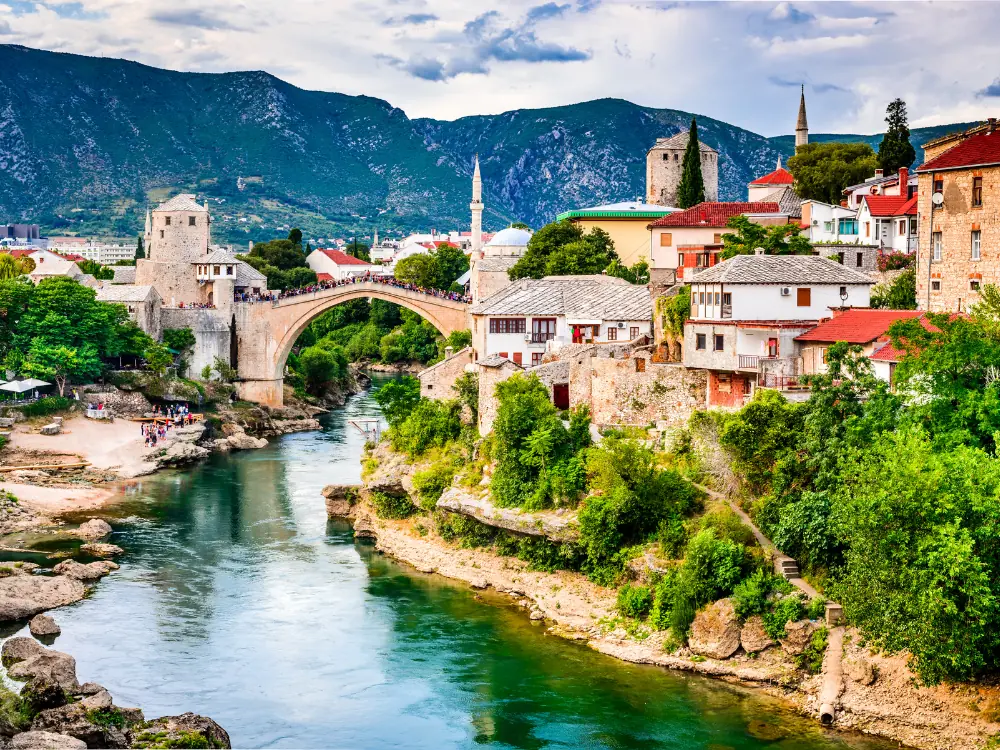
Mostar
When you go on day trips from Split, don’t limit yourself to Croatia. If you are renting a car during your time here, you will also find it very easy to travel across the border to Bosnia & Herzegovina and Serbia, if you so wish. Mostar is also an easy day trip from Sarajevo.
Mostar, in Bosnia and Herzegovina is just a couple of hours away. You can do it as a day trip (although it will be a packed day that involves getting up early in the morning and coming back late at night).
However, you can also opt to stay here overnight if you so wish. This city, located on the banks of the Neretva River has a mild, pleasant Mediterranean climate and a fantastic gastronomic offer. Throughout the year, there are many interesting festivals that are hosted here so check local media and directories to see what is going on during the dates of your trip.
Visit the spring of the Buna River and the Green Cave, the oldest human settlement in the wider area of the city.
Try čevaps, japrak, uštipke, jalan sarma and smokvarka in one of the many restaurants in the beautiful old town centre, and then take a walk along the cool Neretva to Stari Most.
The original bridge here was built way back in 1566 and rebuilt in 2004 after it was demolished in 1993 during the war. After it was restored, it was placed under the protection of UNESCO, and during the restoration, the stone of the original bridge extracted from the bottom of the river was used.
The bridge is known for its traditional diving competition, which is held every year at the end of July. The first jump was officially recorded in 1664, and usually, local young men who are familiar with the Neretva because of its extremely low temperature, which remains at about 10 degrees even in the hottest months, compete.
When in Mostar, you can visit the numerous mosques and churches that can be found throughout the town and its neighborhoods, as well as the skywalk within the Fortica sports and adventure park.
See the Bruce Lee monument in Zrinjevac Park and enjoy the Mostar Blues & Rock Festival and Mostar Film Festival.
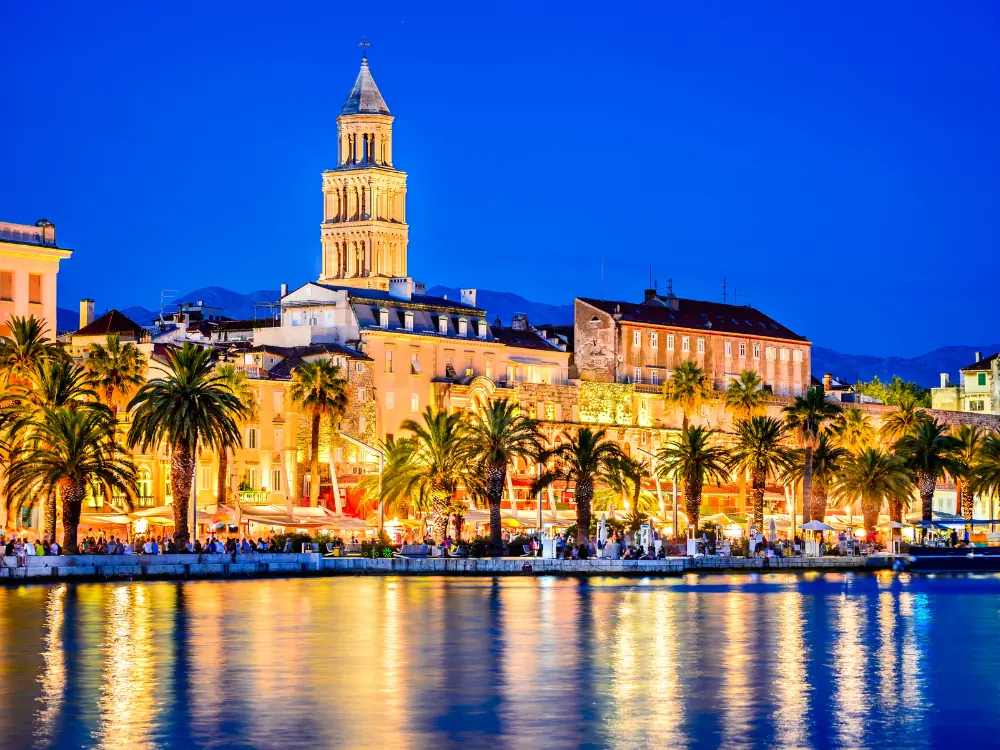
Final thoughts on the best day trips to take from Split
Split is one of the most popular summer travel destinations in Croatia and arguably, all of Europe. While it is no stranger to tourists, most people that travel to the area often simply use Split as a jump-off point to head to the islands of Brač, Korkula, Hvar and the Pakleni islands.
The Plitvice lakes are one of the most popular day trips from Croatia that you can do but by traveling to many of the other destinations on this list, you will find lesser known cultural and natural gems, that are not overrun with tourist hordes, even during the peak season.
Check out these related posts:
Happy travels,
Annick, The Common Traveler
Save this “Best Day Trips From Split” for later – save and pin it!
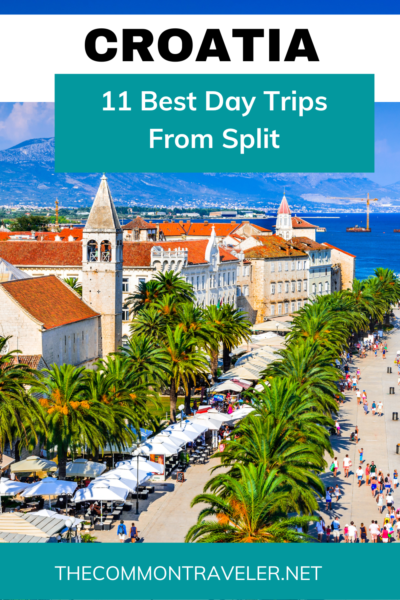

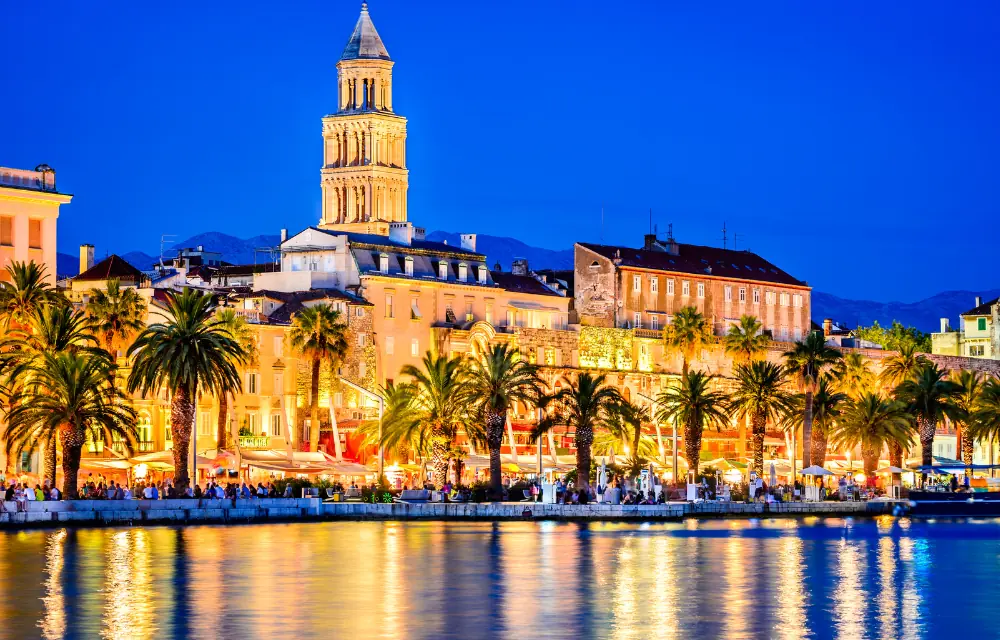
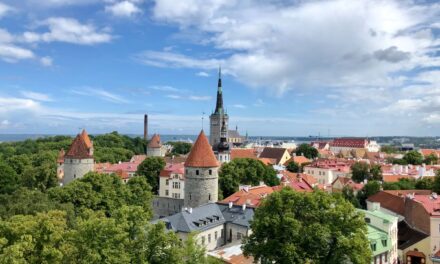

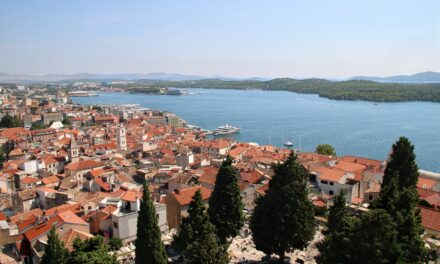

 Raised as a third culture kid living in South America and Europe, Annick caught the travel bug early. As an empty-nester, Annick enjoys sharing her tips for traveling for those with champagne taste and beer budgets.
Raised as a third culture kid living in South America and Europe, Annick caught the travel bug early. As an empty-nester, Annick enjoys sharing her tips for traveling for those with champagne taste and beer budgets.